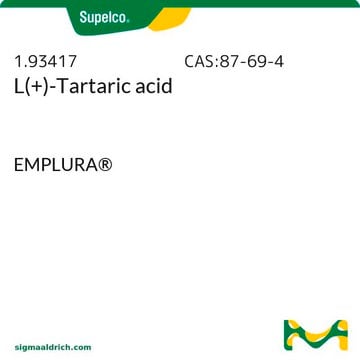1.03726
Metanol
99.9% (GC), suitable for UHPLC, LiChrosolv®
Sinónimos:
Alcohol metílico
About This Item
Productos recomendados
Nombre del producto
Metanol, for UHPLC-MS LiChrosolv®
Agency
suitable for ASTM® 7968
suitable for ASTM® 7979
suitable for DIN 38407-42
suitable for EPA 1621
suitable for EPA 1633
suitable for EPA 533
suitable for EPA 537.1
suitable for EPA 8327
suitable for EPA ACB B21-02
suitable for EPA ACB B23-05b
suitable for EPA OTM-45
suitable for GB 31604.35-2016
suitable for GB 5009.253-2016
suitable for ISO 21675 2019
suitable for ISO 25101
suitable for ISO/CEN 15968-2010
Nivel de calidad
cumplimiento norm.
suitable for FDA C-010.02
densidad de vapor
1.11 (vs air)
presión de vapor
128 hPa ( 20 °C)
410 mmHg ( 50 °C)
97.68 mmHg ( 20 °C)
Línea del producto
LiChrosolv®
Ensayo
99.9% (GC)
Formulario
liquid
temp. de autoignición
725 °F
lim. expl.
36 %
técnicas
HPLC: suitable
LC/MS: suitable
UHPLC: suitable
índice de refracción
n20/D 1.329 (lit.)
Viscosidad cinemática
0.54-0.59 cSt(20 °C)
bp
64.7 °C (lit.)
mp
−98 °C (lit.)
temperatura de transición
flash point 9.7 °C
densidad
0.791 g/mL at 25 °C (lit.)
cadena SMILES
CO
aplicaciones
PFAS testing
Formato
neat
temp. de almacenamiento
2-30°C
InChI
1S/CH4O/c1-2/h2H,1H3
Clave InChI
OKKJLVBELUTLKV-UHFFFAOYSA-N
¿Está buscando productos similares? Visita Guía de comparación de productos
Categorías relacionadas
Descripción general
Aplicación
The product is used as a solvent in studies such as the following:
- high resolution mass spectrometric (HRMS) analysis of per- and polyfluoroalkyl substances (PFAS) in environmental water samples
- UHPLC-MS/MS study of PFAS and/or perfluorooctane sulfonate (PFOS) in sewage sludge and soil samples
Características y beneficios
- suitability tested and specified for UHPLC-MS and UHPLC-UV: for analytical flexibility
- specified quality in positive and negative in positive and negative electrospray ionization (ESI) and atmospheric-pressure chemical ionization-mass spectrometry (APCI-MS) for lowest detection limits and confidence in analyses for all important MS modes (test 1)
—ESI/APCI (-) < 10 ppb
- lowest impurity profile: for interference-free baselines (test 2)
- microfiltered through 0.2 μm filter (test 3) to provide:
—reduced risk of column clogging
- packed in borosilicate glass bottles for minimized metal ion contaminations
- lowest levels of trace metal impurities for a minimum metal ion adduct formation
- lowest level of polyethylene glycol (PEG) impurities in UHPLC-MS solvent lineup (PEG S/N signal-to-noise-ratio < 50)
Nota de análisis
Otras notas
Información legal
Para utilizar con
Producto relacionado
Palabra de señalización
Danger
Frases de peligro
Consejos de prudencia
Clasificaciones de peligro
Acute Tox. 3 Dermal - Acute Tox. 3 Inhalation - Acute Tox. 3 Oral - Flam. Liq. 2 - STOT SE 1
Órganos de actuación
Eyes,Central nervous system
Código de clase de almacenamiento
3 - Flammable liquids
Clase de riesgo para el agua (WGK)
WGK 2
Punto de inflamabilidad (°F)
49.5 °F - closed cup
Punto de inflamabilidad (°C)
9.7 °C - closed cup
Certificados de análisis (COA)
Busque Certificados de análisis (COA) introduciendo el número de lote del producto. Los números de lote se encuentran en la etiqueta del producto después de las palabras «Lot» o «Batch»
¿Ya tiene este producto?
Encuentre la documentación para los productos que ha comprado recientemente en la Biblioteca de documentos.
Los clientes también vieron
Artículos
Pesticide residue analysis of 331 pesticides and 44 metabolites in cabbage samples using Supel™ QuE QuEChERS mixes and Purospher® STAR RP-18e column.
Pesticide residue analysis of 331 pesticides and 44 metabolites in cabbage samples using Supel™ QuE QuEChERS mixes and Purospher® STAR RP-18e column.
Pesticide residue analysis of 331 pesticides and 44 metabolites in cabbage samples using Supel™ QuE QuEChERS mixes and Purospher® STAR RP-18e column.
Pesticide residue analysis of 331 pesticides and 44 metabolites in cabbage samples using Supel™ QuE QuEChERS mixes and Purospher® STAR RP-18e column.
Nuestro equipo de científicos tiene experiencia en todas las áreas de investigación: Ciencias de la vida, Ciencia de los materiales, Síntesis química, Cromatografía, Analítica y muchas otras.
Póngase en contacto con el Servicio técnico







